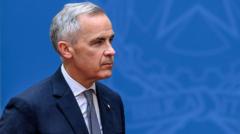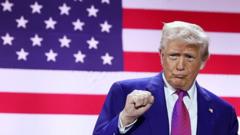As Canadians head to the polls, the specter of Donald Trump's policies and their implications for Canada seep into the electoral atmosphere. The Conservative Party's previously dominant position has significantly weakened, while the Liberal Party—now led by former central banker Mark Carney—emerges as a key player amid rising concerns over the economy and sovereignty.
Tensions Rise as Canada Casts Votes Amid Trump Influence

Tensions Rise as Canada Casts Votes Amid Trump Influence
The 2025 Canadian federal election sees unprecedented political dynamics as Prime Minister Mark Carney faces Pierre Poilievre, with President Trump's looming presence reshaping voter sentiments.
Canadians are heading to the polls today in what is considered one of the most pivotal elections in recent history, with the outcome likely to reshape the country’s political landscape amidst external pressures from U.S. President Donald Trump. As the voting unfolds, the stakes are extremely high, determining not just the next prime minister but also the trajectory of Canada’s handling of economic challenges and foreign relations.
Recent polling reports indicate a shift in public sentiment towards the Liberal Party, which is headed by newly appointed Prime Minister Mark Carney. As voters prepare to elect their parliamentary representatives, the dynamics have shifted dramatically from three months ago when the Conservative Party, led by Pierre Poilievre, held a commanding lead. Factors contributing to this change include President Trump’s trade policies and his contentious comments about Canadian sovereignty, which have significantly altered the political landscape.
Carney presents himself as a pragmatic centrist with a rich background in financial governance, arguing that his administration can better tackle the threats posed by Trump's tariff policies. Conversely, Poilievre promotes a more traditional conservative agenda, focusing on deregulation and reducing the federal government's footprint. His alignment with Trump-like ideologies, however, has prompted some voters to distance themselves from him at this critical juncture.
In this election, a total of 343 parliamentary seats are at stake. Voters will select individuals to represent their specific districts, and the party securing the most seats will form the government, with its leader becoming the prime minister. Polling stations across Canada opened at staggered times to accommodate the vast geographical expanse of the country, and results are expected late this evening.
The Conservative Party’s fortunes have waned in this election, with many former supporters considering Carney as a better option to safeguard against the fallout of Trump’s aggressive economic policies. Additionally, smaller parties, including the New Democratic Party, the Greens, and the Bloc Québécois, are vying for influence, although projected to secure minimal parliamentary seats.
As tensions mount due to international influences, it’s clear that this election stands not only as a referendum on Canadian governance but also on the nation’s identity in relation to the United States. Observers across the political spectrum are keenly aware of the consequences that the new government will face, especially with Trump’s persistent remarks regarding Canadian identity and economic independence. The narrative will no doubt evolve throughout the day as votes are counted and the results start to cascade in.





















